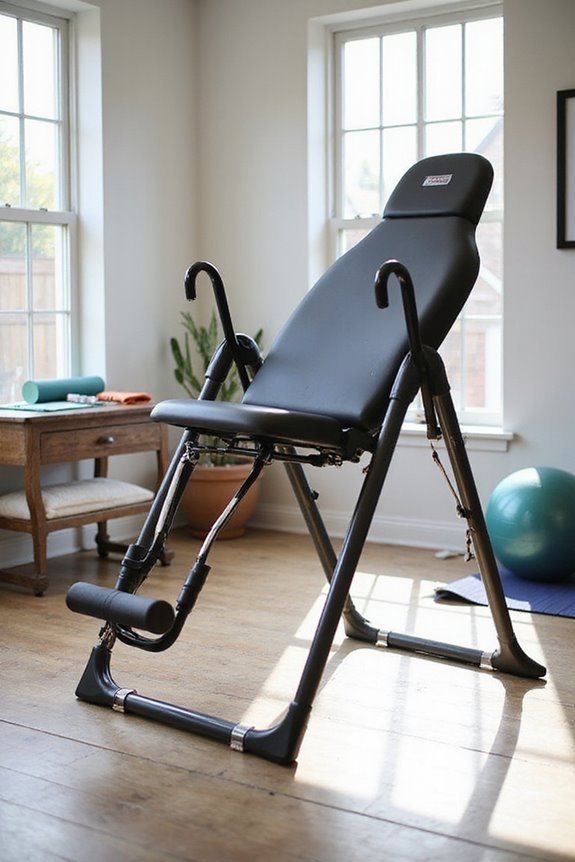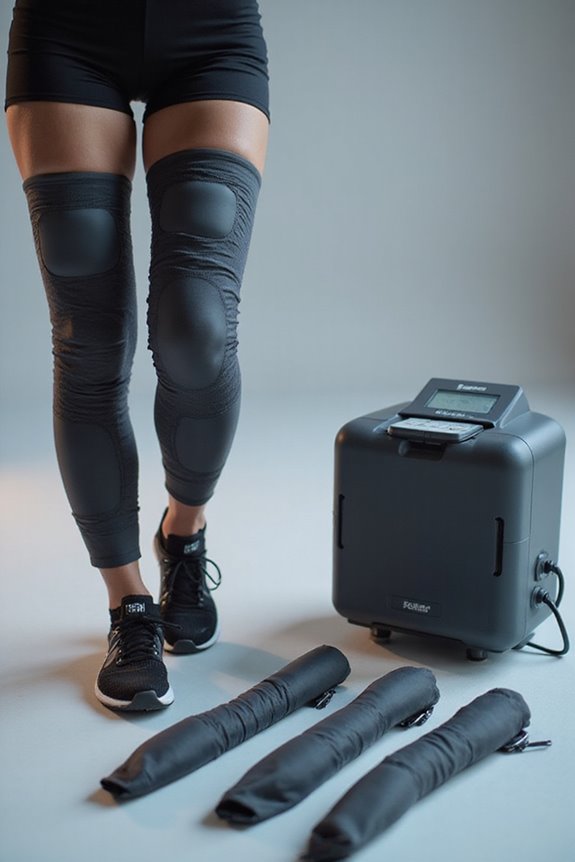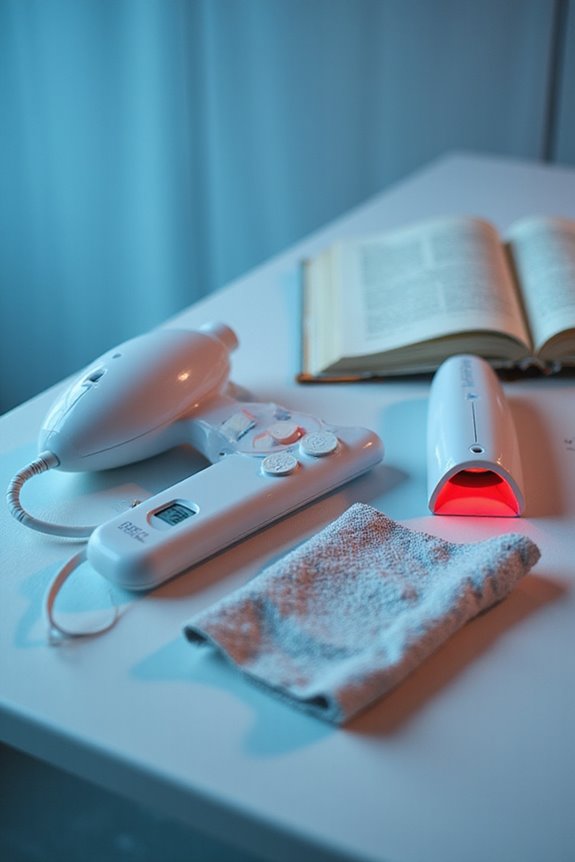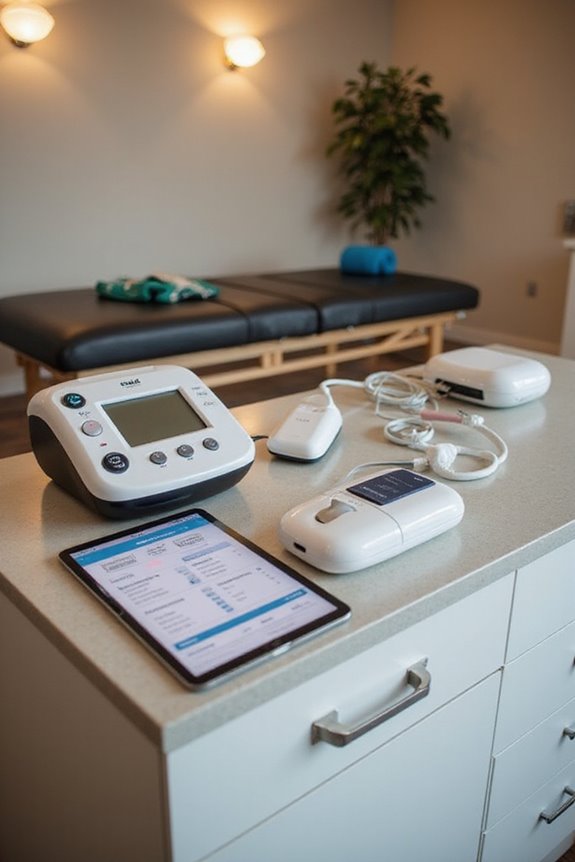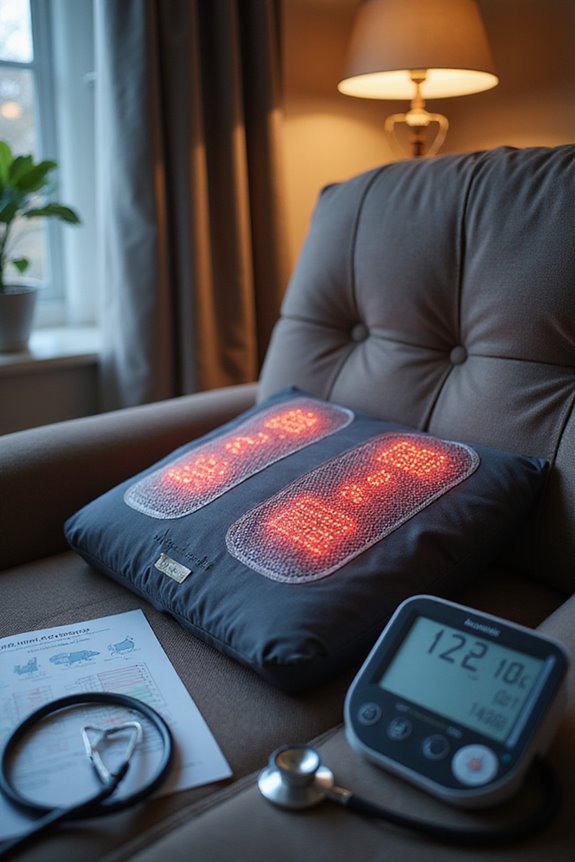Inversion tables can be used to alleviate specific conditions such as low back pain, sciatica, and lumbar disc issues. They promote spinal decompression, enhancing flexibility and potentially reducing the need for surgery by up to 77% for certain diagnoses. Users should, however, consider individual health conditions, as cardiovascular issues, spinal injuries, and elevated ocular pressure can present risks. Consultation with a healthcare professional is advised to guarantee safe application. Additional insights on usage and recommendations follow.
Key Takeaways
- Use an inversion table for short-term relief from low back pain or muscle tension after consulting with a healthcare professional.
- Apply it as an adjunct therapy for lumbar disc protrusions or herniations to potentially reduce pain and surgery necessity.
- Utilize inversion therapy to improve spinal alignment and flexibility, especially if you experience chronic low back pain.
- Avoid use if you have cardiovascular issues, spinal injuries, or certain eye conditions like glaucoma; seek medical clearance first.
- Limit sessions to approximately three minutes at a 60-degree angle to acclimate safely and avoid dizziness or other complications.
Understanding Inversion Therapy and Its Benefits
Inversion therapy, while often regarded as an alternative treatment, operates on established principles of spinal decompression. This method utilizes gravitational force, positioning the body upside down or at an inverted angle to alleviate pressure on spinal discs and nerve roots.
Key benefits include:
- Reduction of spinal compression: Inversion stretches muscles and ligaments, enhancing flexibility.
- Improvement of spinal alignment: Regular use may realign vertebrae, promoting better posture.
- Support for spinal disc health: It aids in nutrient exchange and may delay disc degeneration.
- Decreased need for surgery: Studies indicate over a 70% reduction in lumbar disc surgery necessity.
Inversion therapy, when integrated properly, serves as a valuable adjunct to traditional physiotherapy, enhancing recovery and improving conservative treatment outcomes.
Short-Term Relief From Low Back Pain
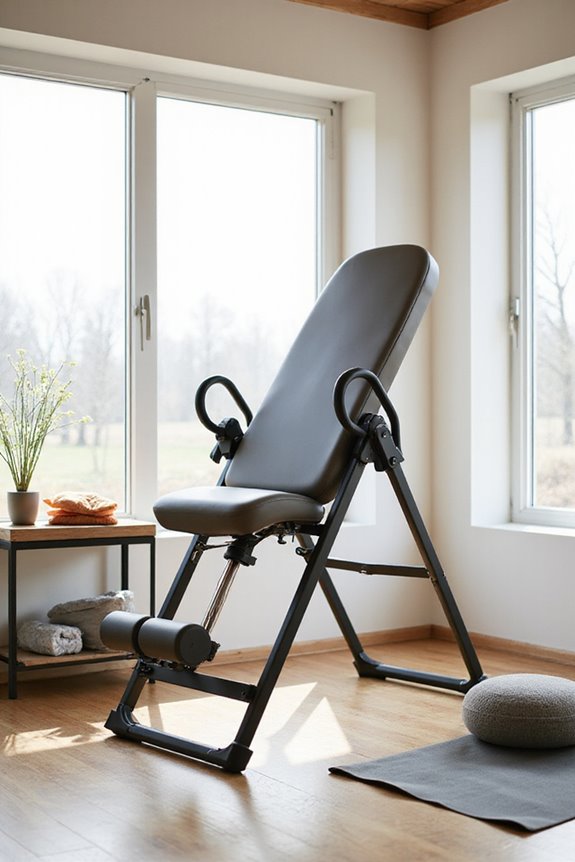
Low back pain, a prevalent issue affecting many individuals, can often be alleviated through the application of inversion therapy. This method utilizes gravity to decompress the spine, promoting muscle relaxation and reducing pressure on spinal structures.
Key points regarding short-term relief include:
- Decompression Effect: Inversion can relieve muscle tension and pinched nerves in the lumbar region.
- Optimal Use: Sessions of approximately three minutes at a 60-degree angle are ideal for relief.
- Inversion Safety: Users should guarantee gradual acclimation to avoid dizziness, consulting a healthcare provider beforehand.
Research indicates that while inversion therapy may provide temporary relief, it is not a substitute for long-term treatment. As a result, individuals should approach this therapy with caution and realistic expectations.
Managing Sciatica Symptoms Effectively
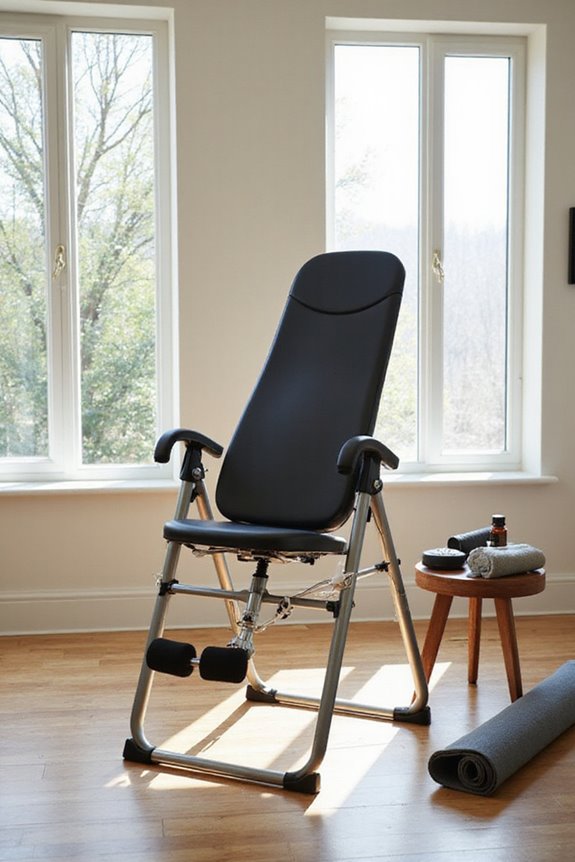
Effective management of sciatica symptoms requires a multifaceted approach that often includes the use of inversion therapy. This method utilizes spinal decompression techniques to create increased space between vertebrae, thereby reducing nerve pressure and alleviating pain from herniated or slipped discs.
Key benefits include:
- Enhanced spinal flexibility and mobility, reducing recurrence risk.
- Diminished muscle tension and spasms, contributing to overall comfort.
- Improved blood circulation in the lower back, supporting tissue health.
Inversion therapy should be used as a complementary treatment alongside therapeutic exercises and professional guidance to guarantee safety and effectiveness. Patients are advised to consult healthcare providers to confirm appropriate use, especially in cases of degenerative spine conditions or other complications.
Recommendations for Specific Diagnoses
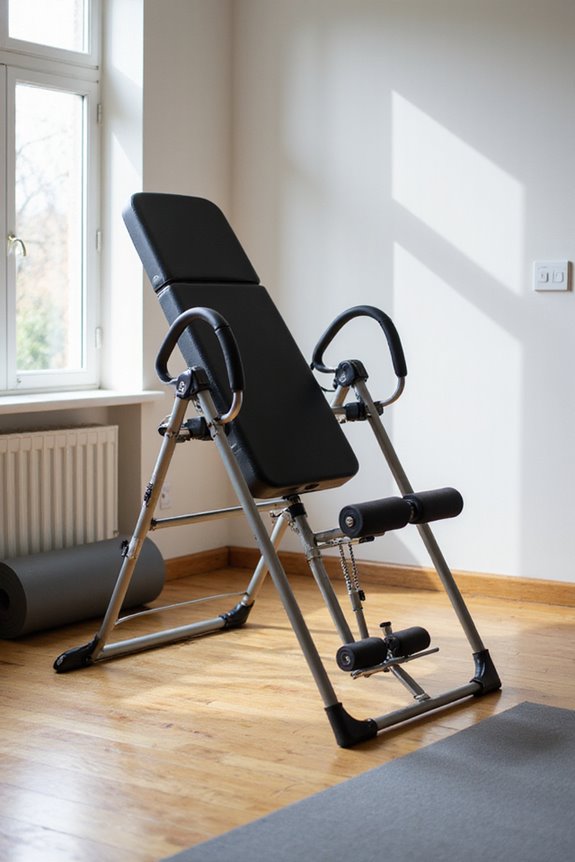
Recognizing the appropriate applications of inversion therapy can enhance treatment outcomes for various spinal conditions.
Lumbar Disc Protrusions and Herniations
- Improves pain scores and disability indices.
- Reduces surgical intervention rates: 21% in inversion therapy versus 39% in controls over two years.
Lumbar Radiculopathy
- Positive effects on pain relief when combined with standard care.
- Reduces surgery necessity by 54-77% for disc-related sciatica.
Chronic Low Back Pain
– Provides short-term relief but is not consistently effective long-term.
Degenerative Disc Disease
– Serves as an adjunct therapy to reduce load on affected discs.
Post-Surgical Spine Patients
– Generally contraindicated for recent surgeries to avoid stress on healing structures.
Practical Applications of Inversion Tables
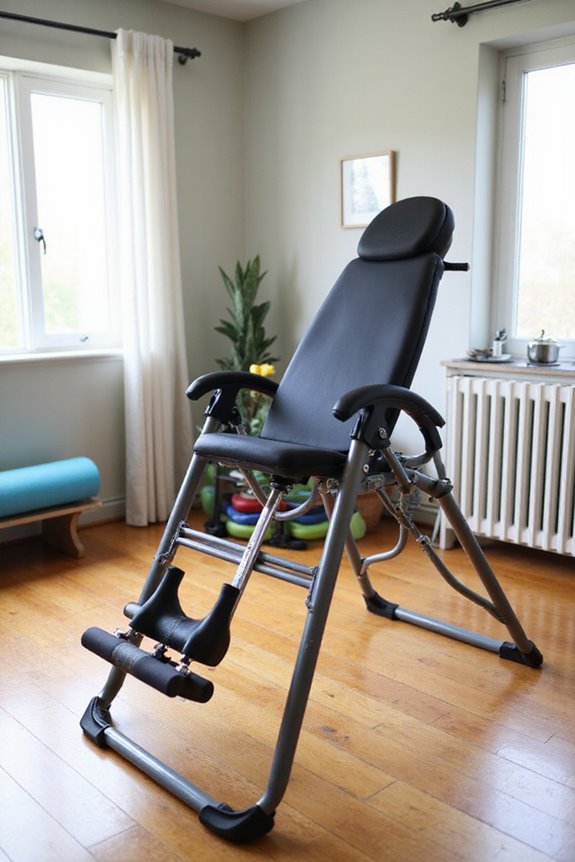
Inversion tables offer a range of practical applications that extend beyond therapeutic use for specific diagnoses.
Core Strengthening
- Inversion tables facilitate inverted exercises targeting core muscles, including abdominals and lower back.
- Crunches and sit-ups performed on these tables build core strength without compressive spinal loads.
- Inverted squats strengthen leg muscles while sculpting glutes.
Joint Health
- Inversions elongate muscles and stretch joints, relieving pressure and reducing discomfort.
- This method promotes muscle relaxation, benefiting athletes and those with physically demanding routines.
- Regular use enhances flexibility, reduces stiffness, and supports overall joint health.
Incorporating inversion therapy into fitness routines can enhance performance, recovery, and well-being, making it a valuable tool for various individuals.
Limitations of Inversion Therapy
While inversion tables can offer numerous benefits for core strengthening and joint health, there are significant limitations and risks associated with their use.
Risks Assessment
- Inversion therapy can elevate blood pressure and potentially lead to cardiovascular complications, particularly for individuals with existing heart conditions.
- Elevated ocular pressure may worsen eye diseases, such as glaucoma.
Contraindications Overview
- Individuals with spinal injuries, osteoporosis, or herniated discs are at risk for further injury during inversion.
- Neurological symptoms, including dizziness or confusion, may signal emergencies requiring immediate attention.
- Prolonged inversion poses systemic risks, including increased intracranial pressure.
Users must be aware of these limitations to guarantee safe practice and avoid serious health complications.
Health Conditions to Consider Before Use
Before utilizing an inversion table, it is essential to assess various health conditions that may affect safety and efficacy.
Cardiovascular Risks
- Inversion therapy can elevate blood pressure and reduce heart rate, posing risks for individuals with hypertension, heart disease, or a history of stroke.
- Patients with these conditions should avoid inversion due to the potential for exacerbation and increased risk of strokes or heart attacks.
Eye Conditions
- Inversion can notably impact eye health, as it increases pressure on the eyeballs.
- Individuals with glaucoma or retinal detachment should refrain from using inversion tables, as these conditions may worsen due to elevated intraocular pressure.
- Any existing ocular disease that compounds pressure issues necessitates caution or avoidance of inversion therapy.
Optimal Timing and Frequency for Sessions
Determining the ideal timing and frequency for sessions on an inversion table is essential for maximizing benefits while minimizing potential risks.
Session Duration
- Begin with 1 to 2 minutes to assess tolerance.
- Gradually increase to 3 to 5 minutes as comfort allows.
- Avoid exceeding 5 minutes to prevent cardiovascular strain.
Session Frequency
- 2 to 3 sessions per day are common for effective results.
- Incorporate sessions into daily routines, such as post-exercise or morning stretches.
- Multiple short sessions are preferable to prolonged use, limiting risks like dizziness.
Timing Considerations
- Morning sessions enhance flexibility; evening sessions promote relaxation.
- Avoid usage immediately after meals or during cardiovascular stress.
Consistency in both duration and frequency is key to safe, long-term benefits.
Monitoring Your Body’s Response
How does the body respond to inversion therapy?
Monitoring one’s body awareness during inversion therapy is fundamental for safe use. Users often experience varied responses, including:
- Cardiovascular Changes: Heart rate may slow, while blood pressure can rise, particularly in those with hypertension.
- Neuromuscular Feedback: Discomfort levels can differ across spinal segments; therefore, monitoring subjective pain is essential.
- Sensory and Emotional Reactions: Users may face emotional lability or dizziness, warranting gradual adaptation to inverted positions.
Regular assessment of physiological parameters is significant. This includes:
- Blood Pressure: Monitoring at different angles is necessary to guarantee safety.
- Heart Rate Variability: Indicates tolerance to inversion.
- Eye Pressure: Important for those with pre-existing conditions.
Response monitoring enhances the overall experience and safety of inversion therapy.
When to Seek Medical Advice Before Use
Inversion therapy can pose risks for individuals with certain health conditions. Before using an inversion table, it is essential to conduct a risk assessment with a healthcare professional, especially for those with specific medical histories.
Cardiovascular Conditions
- Hypertension and heart disease necessitate medical clearance.
- Cerebral sclerosis and vascular disorders require consultation.
Eye Conditions
– Glaucoma and retinal issues need evaluation to prevent vision damage.
Musculoskeletal Disorders
– Osteoporosis and herniated discs require professional guidance.
Other Health Situations
– Pregnant women and those with chronic illnesses should seek advice.
Inversion therapy can be beneficial, but safety must be prioritized through informed discussions and proper medical evaluation.
Frequently Asked Questions
How Do I Choose the Right Inversion Table for Me?
Choosing the right inversion table involves evaluating user weight capacity and essential inversion table features. Adjustable settings and comfort enhancements guarantee a suitable fit, fostering a sense of belonging to a community that values health and wellness.
Can I Use an Inversion Table if I Have Arthritis?
Approximately 54 million Americans have arthritis symptoms, making inversion therapy a potential concern. While mild inversion might provide temporary relief, consulting a healthcare professional is essential to assess safety and avoid exacerbating joint issues.
How Long Should Each Inversion Session Last?
Each inversion session should last 3 to 5 minutes, adhering to recommended intervals to promote relaxation and spinal benefits. Gradual increases in duration are encouraged, ensuring comfort and safety for ideal outcomes in practice.
Is It Safe to Use an Inversion Table Daily?
Daily use of an inversion table offers potential benefits, like back pain relief, but carries risks, including cardiovascular strain and muscle injury. Individuals should consult professionals to evaluate personal health conditions before considering daily inversion.
What Should I Wear During an Inversion Therapy Session?
Dressed for success, one should wear comfortable clothing and safety gear during inversion therapy. Lightweight, breathable fabrics guarantee freedom of movement, while avoiding bulkiness assures safety, creating an enjoyable experience that fosters a sense of belonging and wellness.

